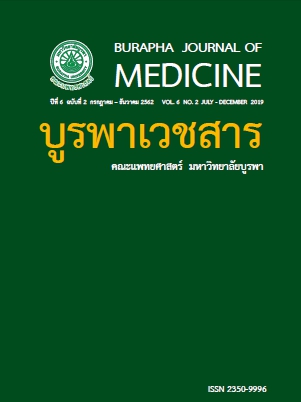ความสัมพันธ์ระหว่างการรับความรู้สึกข้อต่อ กับความสามารถในการทรงตัวในผู้สูงอายุ
คำสำคัญ:
ความสามารถในการทรงตัว, การรับความรู้สึกข้อต่อและกล้ามเนื้อ, การล้ม, ผู้สูงอายุบทคัดย่อ
Introduction Fall is the most common accident of the elderly, and has both physical factors
(such as fracture, joint dislocation or hemiplegia) and mental factors (such as stress and a fear
of falling). An Increase to the risk of falling is the loss of balance – with good balance control
generated from the somatosensory, musculoskeletal and nervous systems. Proprioception is
one of the senses of the somatosensory system, and has an important role in balance control.
Degeneration of the body in the elderly includes degeneration of proprioception, and therefore
the assessment of proprioception is a necessary prevention of accidental fall in elderly patients.
Methods 50 elderly participants were assessed with “TUG” tests for joint position sense
(proprioception) at their ankles and toes by our physical therapist. The 50 participants selected
were able to walk independently.
Results There was no correlation between joint position of all the joints with the TUG test
results (p< 0.05).
Conclusions Proprioception and TUG results in the elderly is not correlated. However, an
assessment of proprioception and TUG is suggested for the prevention of falling.
เอกสารอ้างอิง
รอดจากภัย. ปัจจัยที่มีความสัมพันธ์ต่อพฤติกรรม
การป้องกันการหกล้มของผู้สูงอายุ จังหวัดชลบุรี.
วารสารมหาวิทยาลัยนเรศวร: วิทยาศาสตร์และ
เทคโนโลยี. 2560; 25: 23-33.
2. รายงานการส?ำรวจสุขภาพประชาชนไทยโดยการ
ตรวจร่างกาย ครั้งที่ 5 พ.ศ. 2557. [อินเตอร์เนต].
2558 [เข้าถึงเมื่อ 10 กรกฎาคม 2562]. เข้าถึงได้
จาก: https://www.hiso.or.th/hiso5/report/
sreport.php?m=4
3. FULLER GF. Falls in the Elderly. Am Fam
Physician. 2000. 61: 2159-68.
4. อัจฉรา สาระพันธ์, ณัฐกฤตา ศิริโสภณ, ประเสริฐ
ศักดิ์ กายนาคา, สมบัติ อ่อนศิริ, บุญเลิศ อุทยา
นิก, สุพัฒน์ ธีรเวชเจริญชัย และคณะ. ปัจจัยที่มี
ความสัมพันธ์ต่อพฤติกรรมการป้องกันการหกล้ม
ของผู้สูงอายุ. วารสารพยาบาลทหารบก. 2560;
18: 215-22.
5. ละออม สร้อยแสง, จริยาวัตร คมพยัคฆ์, กนกพร
นทีธนสมบัติ. การศึกษาแนวทางการป้องกันการ
หกล้มในผู้สูงอายุชุมชนมิตรภาพพัฒนา. วารสาร
พยาบาลทหารบก. 2557; 15: 122-9.
6. สมลักษณ์ เพียรมานะกิจ, พัชรินทร์ พุทธรักษา,
สุพิน สาริกา,วิไล คุปต์นิรัติศัยกุล. ความสามารถ
ในการทรงตัวของผู้สูงอายุในชุมชนอ?ำเภออัมพวา.
วารสารายภาพบ?ำบัด. 2560; 39: 52-62.
7. Ribeiro F, Oliveira J. Aging effects on joint
proprioception: the role of physical activity
in proprioception preservation. Eur Rev
Aging Phys Act. 2007; 4: 71–76.
8. Han J, Anson J, Waddington G, Adams R,
Liu Y. The role of ankle proprioception
for balance control in relation to sports
performance and injury. Biomed Res Int.
2015; 1-8.
9. Sohna J, Kim S. Falls study: Proprioception,
postural stability, and slips. Biomed Mater
Eng. 2015; 26: 693–703.
10. ไพฑูรย์ พัชรอาภา. สถานการณ์ผู้สูงอายุ ผู้
สูงอายุกับครอบครัว ชุมชน สังคม. [อินเตอร์
เนต]. [เข้าถึงเมื่อ 10 กรกฎาคม 2562]. เข้า
ถึงได้จาก: https://www.dop.go.th/
download/formdownload/download_
th_20162203134717_1.pdf.
11. B o o n p l e n g W , S r i w o n g w a n W ,
Sattawatcharawanij P. Rate and associated
factors for falls among elderly people:
Chaopraya waterfront community in
Nonthaburi province. J Nurs Sci. 2015; 33:
74-86.
12. ทิวาพร ทวีวรรณกิจ, สุกัลยา อมตฉายา, พรรณี
ปึงสุวรรณ, ลักขณา มาทอ. การทรงตัว การล้ม
และคุณภาพชีวิตในผู้สูงอายุที่เคลื่อนไหวและไม่
เคลื่อนไหวร่างกายเป็นประจ?ำ. วารสารเทคนิค
การแพทย์และกายภาพบ?ำบัด. 2551; 22: 271-9.
13. Stephen GW. Clinical neuroanatomy. 27th
ed. McGraw-Hill Companies: USA; 2013.
14. Menz H B, Morris M E and Lord S R. Foot
and ankle risk factors for falls in older
people: a prospective study. Journal of
Gerontology: Medical Sciences. 2006;
61A(8): 866–87.
15. Ko T, Lee S and Lee D. Manual therapy
and exercise for OA knee: effects on
muscle strength, proprioception, and
functional performance. J Phys Ther sci.
2009; 21: 293-9.



